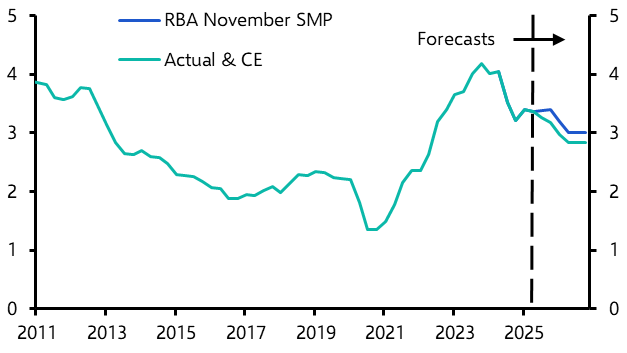The conventional view of the long-term prospects for the global economy can be summarised as: EMs good, DMs bad. Like most things, however, we suspect that the conventional view is likely to be wrong.
Last week we published our first Long Term Global Economic Outlook, which sets out forecasts for the major developed and emerging economies out to 2040. You can find it on our website here. A key message is that we don’t share the widespread pessimism over the long-term outlook for developed economies, but that we do think that the consensus view of EMs is overly optimistic.
A common factor behind gloomy projections for long-run growth in DMs is a belief that the latest wave of technological change – focussed on digital and AI – will not transform productivity growth in the same way that previous bouts of technological development did. We’re not so sure. After all, while the productivity data have been weak in recent years, this may well be a hangover from the global financial crisis that should eventually fade. What’s more, one of the lessons from previous waves of technological development – from steam power, to electricity, to desktop computing – is that it takes time for infrastructure to adapt in order to realise the benefits to productivity. Digital and AI is unlikely to be any different.
The upshot is that, while demographic pressures will provide a headwind to growth in developed markets, we expect growth in GDP per capita to accelerate from its current low rates in most advanced economies over the next decade or so. This is particularly true of the US.
In contrast, we’re less optimistic – at least compared to the relatively rosy consensus – on the long-run outlook for emerging markets. Admittedly, growth in EMs is still likely to outpace that of DMs over the next 20 years – we expect real GDP growth in emerging economies to average 3.5% a year out to 2040, while in advanced economies it’s likely to average 1.7%. But we don’t share the view that we’re on the cusp of an “EM century” in which incomes in the emerging world converge rapidly and inexorably to those in developed markets. In fact, we think that the pace of convergence will slow to a crawl in China, as structural constraints weigh increasingly on productivity growth. And we think that convergence will reverse in a handful of EMs, including Brazil and South Africa.
Accordingly, while a combination of liberalisation and globalisation lifted all EM boats over the past couple of decades, rapid growth over the next 20 years will be confined to a handful of emerging economies, the most important of which is India.
All of this will have profound implications for how the world looks in 2040. Some highlights from our Outlook include:
- The US will remain the world’s fastest growing advanced economy, but its share of global GDP will edge down from around 20% currently to 15% or so by 2040.
- GDP growth in China will slow to as little as 2% by over the next decade or so, as severe resource misallocation pulls down trend productivity.
- India will establish itself as the world’s fastest growing major economy – and by 2040 will be its third largest.
- Italy will remain the weakest link within the euro-zone, and will ultimately have to undergo some form of debt restructuring. What’s more, there’s a significant (and still underappreciated) risk that at least one country leaves the single currency.
- Africa will account for a quarter of the world’s population by 2040 – but will remain easily its poorest region.
Investment returns over the next year will be influenced by cyclical factors, including the prospect of much slower growth in the US and China. I’ll return to this theme in next week’s note. But it’s the broader shifts in the global economy that we explore in our new Long Term publication that will determine returns over a longer horizon.
In case you missed it:
(Requires login)
- Our Senior US Economist, Michael Pearce, dissects the recent flattening of the yield curve.
- Our China team have published their latest “Property Handbook”, which takes a deeper look at the challenges facing the sector and explains what they mean for the real economy.
- Our Europe team survey the latest data and find growing signs of a recession in Italy.


